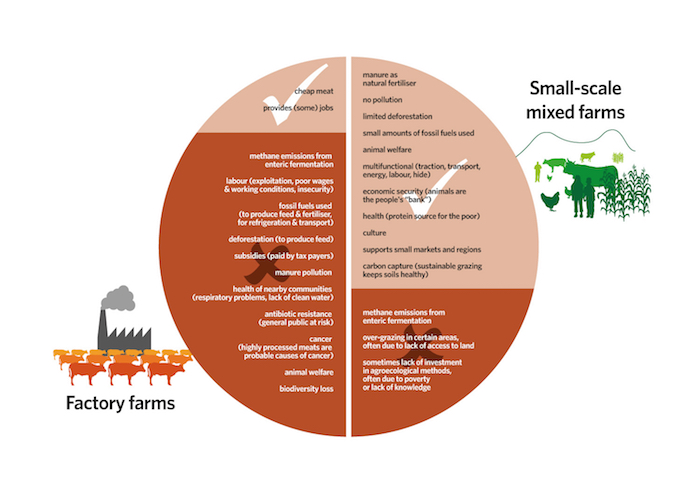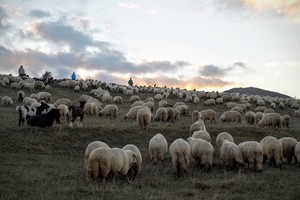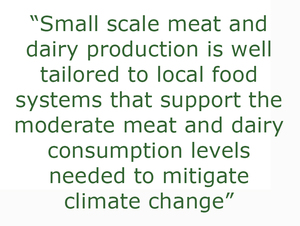As temperatures rise across the globe, meat and dairy have been found to be a major culprit. Still, the industrial meat industry actively facilitates the growth in consumption rates. We can only solve the climate crisis if we take meaningful steps towards agroecology and food sovereignty.
Our global food system is one of the biggest drivers of climate change. It accounts for over one third of all global greenhouse gas emissions, according to latest estimates from the Meridian Institute. Livestock represent the biggest portion of this. Research done by GRAIN shows that it is the industrial meat and dairy complex that produces this tremendous damage, not traditional livestock reared by smallholders. Deforestation, industrial feed crops, use of chemical fertilizers, manure lagoons, transport and refrigeration, and massive waste are all central elements of the industrial meat and dairy complex responsible for huge amounts of climate gases. The FAO calculated that, today, meat production alone – especially that of the industrial type – generates more greenhouse gas emissions than all the world’s transport combined.
Yet, meat consumption is soaring in many places of the world. If current trends continue global meat consumption will grow a further 76% from current levels by 2050, according to the latest studies, pushing us deeper into the climate crisis. If, on the other hand, heavy eaters of industrial meat reduced their unhealthy levels of consumption to the World Health Organization’s recommended amounts, the world could eliminate 40% of all current greenhouse gas emissions.
So, why is meat consumption increasing so much beyond sustainable and healthy levels? The most common narrative is that the growing middle class in many newly industrialising countries can now afford to eat more meat, and thus jump on the opportunity. Indeed, the projected growth of meat consumption is especially stark in countries like China, Brazil, India and other countries in their regions. But that is only part of the story.
Meat-free Thursdays
The city of Ghent, Belgium, became the first city in the world to officially stimulate its citizens to have a weekly vegetarian day. The structural government support and involvement in this initiative sets it apart from other campaigns promoting reduced meat consumption. In partnership with the NGO, EVA (Ethical Vegetarian Alternative), the city of Ghent launched ‘Thursday Veggie Day’ in 2009. Response among local citizens and local public institutions has generally been very positive. People’s awareness of the issues concerning meat (and especially the global warming impact) is rising. Two years after its launch, 60,000 people indicated that they participate several times a month and, 94% of public school students were choosing the vegetarian meal on Thursdays. Beyond the city, from Cape Town to São Paulo, cities are launching similar campaigns that were inspired by Ghent.
Source: Leenaert, T (2016). Meat moderation: a challenge for government and civil society. In: Sustainable Food Planning: evolving theory and practice (Viljoen, A and Wiskerke, J. S. C Eds.).
The other side of the story is that the industrial meat industry actually facilitates the growth in consumption rates. It produces cheap meat surpluses which are traded as global commodities and pushed onto markets everywhere. As a consequence, industrial meat is the most rapidly growing segment of meat and dairy production, accounting for 80% of the global growth in recent years.
Propping up the corporate meat market
So, why can industrial meat be produced so cheaply and expand so fast across the globe? Confinement of animals at a high stocking density is one part of a systematic effort to produce the highest output at the lowest cost. Yet, at least three key structural factors are at play here: corporations are fighting off any regulation of their sector, industrial meat is highly subsidised, and trade deals are signed to get it to expand massively into markets across the globe.
Attempts by governments to regulate meat consumption is met with resistance by the industry. When Germany drafted guidelines to reduce meat consumption, demonstrating that a 50% cut by 2030 would be “crucial to climate protection,” the industry lobbied hard. By the November 2016 launch date, the country’s climate change plan had been stripped of any reference at all to greenhouse gases in the agriculture sector. Similar stories can be told of the meat lobby in the United States (US), Brazil and other countries where industrial meat is strong.
Furthermore, the industry receives subsidies in many countries. For example, in 2013, the European Union paid US$ 731 million to its cattle industry alone. The same year, the US Department of Agriculture paid more than US 300 million US dollars to just six huge meat companies in order to get industrial meat and dairy on school meal trays, compared to just a fraction of that to fruit and vegetable suppliers.
But the big guns in the industry’s arsenal are ‘free trade’ agreements. These corporate trade deals artificially prop up production and consumption by promoting the dumping of cheap meat and dairy into low income countries. They include clauses that eliminate protection for local farmers from foreign competitors, that make it illegal to grant preference to local suppliers or products, and that allow foreign companies to sue governments that adopt social or environmental legislation that they think could undermine their profits.
Without permissive regulations, subsidies and ‘free trade’ agreements, industrial meat would simply be too expensive to buy. These structural factors give priority to profits for an elite few and dismiss the massive environmental and social costs incurred by the corporations.
Support smallholders, agroecology and local markets
Corporate lobby groups, scientists and development agencies often paint small scale livestock holders in poor countries as the climate culprits because of their animals’ low efficiency in converting calories to meat or milk on a per capita basis. Yet, a narrow focus on efficiency and emissions intensity ignores the multiple benefits of mixed, multi-functional and biodiverse small scale livestock production systems. These include providing local livelihoods, improving soil health, greater climatic resilience and other positive environmental and public health benefits. Small scale meat and dairy production is already well tailored to local food systems that support the moderate meat and dairy consumption levels needed to mitigate climate change (see figure).

Shrinking the water and carbon footprint of school food
Oakland Unified School District (OUSD) in the state of California reduced animal protein on school menus by 30% while increasing fruit, vegetables, and legumes. When kids ate meat, it came from local organic producers. The result: a 14% reduction in the school’s food carbon footprint. This translates into 600,000 kg of CO2-equivalents saved per year – the same as driving 2.4 million kilometres less per year or covering all of OUSD’s roofs with solar panels with no additional cost. They also reduced their water footprint by 6%, from 428 to 401 litres per meal served, saving a total of 159 million litres of water per school year and US$ 42,000 in the cost of the meals. Perhaps most remarkable: the children reported increased satisfaction with the healthy, regionally sourced meals.
Source: Hamerschlag, K. and Kraus-Polk, J. Shrinking the Carbon and Water Footprint of School Food. A recipe for combating climate change. 2017.
We can only solve the climate crisis if we take meaningful steps towards agroecology and food sovereignty. To achieve this, we need bold moves to disincentivise the production and consumption of cheap industrial meat and dairy. We also need to stop trade deals that prop up the massive international trade in meat and dairy products. Instead, small scale, local and agroecological meat and dairy production and marketing should be supported.
In this process, livestock will once again become integrated into diversified farming systems, while meat and dairy regain their proper place in peoples’ diets. This is the approach that is needed to keep the world liveable for future generations. The task is daunting, but the stakes have never been higher.
This article is based on a series of publications produced by GRAIN. Full references and sources for the figures quoted in this article can be found here: https://www.grain.org/e/5639
Source: Farming Matters https://www.ileia.org/2017/06/26/climate-meat-markets/


